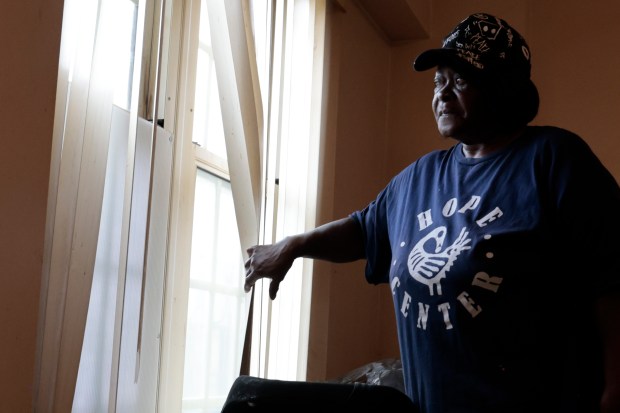The Chicago Housing Authority has hired a former Environmental Protection Agency staffer to head up a new division focused on environmental concerns and hazards for residents living in more than 21,000 units of public housing as part of a series of initiatives for 2025 aimed at offering a course correction for the embattled agency.
Elizabeth Poole will lead the new division as the director of healthy homes after a nearly 15-year career at the EPA. Poole said she left her role as the children’s health coordinator in the EPA’s environmental justice office due to the change in administration. Billionaire Elon Musk’s Department of Government Efficiency and President Donald Trump have unleashed severe federal workforce cuts and rollbacks of environmental protections, including at the EPA.
Poole, who started April 14, and her newly hired team of two other former EPA staffers will begin their work by focusing on lead-based paint hazards as they build out the new program. The team aims to identify solutions to mitigate or eliminate environmental contaminants and risks through not only physical building improvements, but also by providing families and property owners and managers with tools and resources to create healthier spaces.
“If it is not good enough for my child, it is not good enough for any child,” Poole said in an interview with the Tribune. “That is how I work. That is how I live. That is how this team is going to function.”
The new hire comes to the agency, the third largest public housing authority in the country, with a daunting task as CHA grapples with executive leadership turnover, long-held frustrations from residents over building conditions and a court order to pay $24 million to two residents who sued over alleged lead paint poisoning of their two children.
Eight high-ranking officials have left the housing authority since August, including one who was fired. CHA is also in the midst of hiring a new CEO, with a new leader expected by the middle of the year.
Residents at Dearborn Homes in the Douglas neighborhood and Henry Horner Homes in the East Garfield Park neighborhood have shared their concerns with the Tribune just in the last nine months about their living conditions, saying they have felt “neglected.” In January, hundreds of residents were evacuated from the Patrick Sullivan Senior Apartments on the Near West Side due to a burst pipe, which resulted in flooding and the loss of heat and hot water. The week prior, a jury found CHA responsible for two children’s lead paint injuries.
Interim CHA CEO Angela Hurlock has said CHA is “undergoing a significant transition.” In February, Mayor Brandon Johnson joined Hurlock and other CHA officials to launch a “year of renewal,” which they said will address “past challenges” around transparency and engagement with residents and include moves meant to increase housing and safety for its more than 65,000 households.
The agency said it plans to “rebuild trust” by launching a resident survey in June to help shape CHA programs, policies and operations; improving private property management of CHA buildings, with a current selection process in the final stages to find new “local and community-based organizations”; strengthening its collaboration with Chicago’s Department of Housing to help develop the city’s next five-year housing plan; and by creating Poole’s new division.
CHA has also recently hired a new sustainability manager from the EPA who will work with Poole’s team in addition to her other responsibilities. Kimberly Nevels, the former head of diversity, equity and inclusion at the U.S. Department of Housing and Urban Development, is filling CHA’s role as deputy chief of fair housing and policy. As of Monday, the authority replaced its chief of staff — a position that had been vacant since February — with Kemena Brooks. Brooks worked in real estate development locally.
Poole, who started working with CHA this year while still at the EPA through teaching Altgeld Gardens residents about environmental health exposures, said lead-based paint is not just a problem for CHA, but also nationally. The Midwest in particular struggles, she said, because it has an older housing stock and not enough qualified workers to deal with the issue. Poole wants to tackle that challenge while at CHA, including by educating residents on how to properly identify hazards and training some through the agency’s workforce development program to help staff up the lead paint remediation labor field.
The team, which is housed under CHA’s property and asset management division, does not yet know where it will begin its lead safety work in CHA’s massive rental portfolio, Poole said, as they are still examining data and launching the entire division.
“The country as a whole has done a really remarkable job of reducing lead-based paint hazards, whether it’s from emissions or in soil or in paint,” said Poole, who brings lead-related experience from her time at the EPA. “The goal is always to get to zero, and, in my opinion, the last mile of the marathon is the hardest. … We have to start being really purposeful and intensive about where we’re eliminating the last hazards.”
All of CHA’s work to educate families on lead hazards and other environmental issues such as asthma triggers and mold will focus on “low cost, no cost, low effort” tools to minimize adding burdens to families, Poole said.
The division will create a new corner of CHA’s website about healthy homes with resources to help people with decision-making, including how to clean properly with safer products. The team will also have a centralized email address and potentially a widget on the website, where people can send complaints about their living conditions to make sure, Poole said, that “we’re being more responsive, accountable, transparent” for residents.
Brenda Moore, a roughly 14-year resident of Dearborn Homes, said there is a new property manager who has “stepped up” since she spoke with the Tribune last year about the disrepair at the 668-unit site with 16 multistory buildings. The trash chutes have been fixed, she said, but the elevators still constantly are broken, two key issues for the many disabled and older Dearborn residents, including herself.
“If they can find somebody to take care of half of the issues that are going on, that’s great,” Moore said. “That would be a big help. Children and seniors need to be safer in their environment,” including from crime.
Dearborn Homes was constructed in the late 1940s, with only one elevator in each of the buildings. Modernizing the existing elevators requires they be taken offline for months, which is why CHA has said it will add a second elevator to each building on the campus so that it can update the older elevators and increase accessibility. The agency started a feasibility study for the project and expects it to conclude this year, said CHA spokesperson Matthew Aguilar. The modernization effort is included in CHA’s five-year capital plan and estimated to cost $40 million.
It’s not clear how much money will be dedicated to Poole’s division.
Poole said she thinks the biggest challenge will be to build a new program from scratch and in a space — public housing — that her team has not worked in before. The division is working with the New York City Housing Authority, which has an existing healthy homes team, as well as HUD, the Illinois Department of Public Health and the EPA to help shape its work. The team will continually improve its programs, Poole said.
“Our goal in the next year or so is to really engage with all of the different programs at CHA to see how we can fit in with what they are doing,” Poole said. “… I would like to see healthy homes champions across the agency.”
Alexa Burnett, an EPA employee who worked with Poole for two years, including as her mentee, said Poole is “one of the most intelligent people I have ever met” and “not the average government employee.” Poole sees bureaucratic red tape, Burnett said, and will still try to do the work when another employee might just throw up their hands. Poole is “someone who can just make things happen,” said Burnett, who spoke with the Tribune as a member of the EPA’s union.
“I really think she is going to thrive (in the new role),” Burnett said. “CHA is lucky to have her.”
Poole emphasized residents and communication with them in her interview with the Tribune.
“Everybody wants a healthy home. That’s a no-brainer,” Poole said. “We just have to all get on the same page of this is where we are going with this program.”





